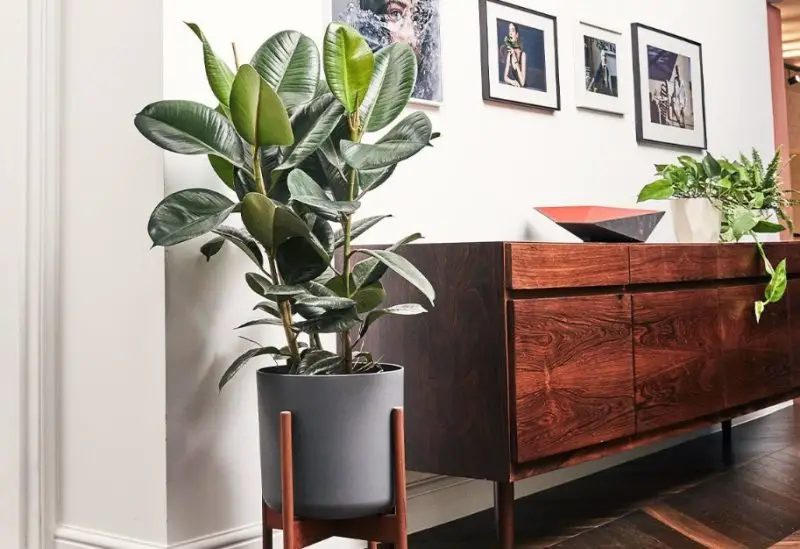The rubber tree (Ficus elastica) is a popular indoor plant admired for its large, glossy leaves and air-purifying qualities. Native to Southeast Asia, this versatile plant can adapt well to a range of indoor environments, making it an excellent choice for homes and offices alike. It not only adds a touch of greenery and elegance to any space but also contributes to a healthier indoor atmosphere by filtering out toxins.
To ensure your rubber tree thrives, it is essential to provide the right care. With proper attention to its lighting, watering, and humidity needs, this plant can grow into a stunning focal point in your home.
This ultimate guide to rubber tree plant care will help you understand everything you need to create the perfect environment for your beloved foliage.
Understanding the Rubber Tree Plant

Overview of the Rubber Tree Plant
The rubber tree, scientifically known as Ficus elastica, is a tropical evergreen plant that has become a beloved choice for indoor gardeners worldwide. With its large, glossy leaves and impressive growth habit, the rubber tree offers both beauty and air-purifying benefits, making it an ideal addition to homes and offices. Native to Southeast Asia and parts of India, the rubber tree thrives in warm, humid environments but has adapted well to indoor conditions, making it a versatile and easy-to-care-for houseplant.
Although it can reach considerable heights in its natural habitat, the rubber tree’s growth can be controlled indoors with proper care, allowing it to fit into a variety of spaces. As a member of the Ficus genus, it shares its family with other popular houseplants such as the fiddle leaf fig (Ficus lyrata) and the weeping fig (Ficus benjamina). Each of these plants shares the same basic care needs but has unique characteristics that make them distinct.
Rubber Tree Plant Characteristics
Rubber trees are known for their striking, large, glossy leaves that provide a bold, dramatic look to any space. These leaves can range in color from a deep, rich green to variegated patterns of white, cream, and green. The variegation adds an extra layer of beauty and interest to the plant, making it a unique and attractive choice for home décor. The leaves grow alternately along the branches and are leathery in texture, which adds to the plant’s resilience and ability to tolerate various indoor environments.
One of the most appealing aspects of the rubber tree is its growth habit. In optimal conditions, this plant can grow to be quite large, reaching up to 6 feet (1.8 meters) indoors. Its sturdy, upright structure makes it an excellent choice for creating vertical interest in a room or for filling empty corners with greenery. As the plant matures, its trunk becomes more pronounced, adding to the plant’s overall aesthetic. It’s worth noting that the rubber tree grows slowly compared to other indoor plants, but over time, it can become a striking focal point in any room.
While the rubber tree produces small, inconspicuous flowers in its native habitat, these blooms are rarely seen indoors. The plant may also bear fruit, but this is uncommon when grown in indoor environments. In its natural habitat, the rubber tree is also known for producing latex, which was historically used to make rubber products. However, this latex production is not as prevalent in indoor-grown plants.
In terms of overall structure, the rubber tree develops a single central trunk with branches extending from it. The leaves grow alternately along the branches, creating a symmetrical, bushy appearance. As the plant matures, you may notice that the leaves become larger and more abundant, contributing to its lush, tropical appearance. This makes the rubber tree an attractive addition to any space, especially for those who appreciate large, dramatic houseplants.
Adaptability to Indoor Environments
Though the rubber tree is native to tropical regions, it has shown remarkable adaptability to indoor environments. As long as the plant receives adequate light, warmth, and humidity, it can thrive indoors for many years. The plant’s ability to tolerate average household humidity levels makes it suitable for a variety of indoor settings, from living rooms to office spaces.
Its resilience to different environmental conditions, combined with its attractive appearance, makes the rubber tree one of the top choices for houseplant enthusiasts. It can adapt to moderate light conditions but performs best when placed in bright, indirect light. This makes it suitable for spaces that may not receive direct sunlight all day but still offer sufficient brightness.
In addition to its adaptability, the rubber tree is known for being relatively low-maintenance compared to other indoor plants. While it does require some attention to detail in terms of watering, fertilizing, and occasional pruning, the plant is forgiving of minor care mistakes, making it a great option for both beginner and experienced plant owners.
With proper care, the rubber tree can become a centerpiece of your indoor garden, offering both visual appeal and air-purifying benefits. This plant is particularly well-suited for individuals seeking a low-maintenance yet visually striking plant that can fit into a variety of indoor spaces. Whether placed in a living room, office, or entryway, the rubber tree’s graceful presence will enhance any setting.
Choosing the Right Location for Your Rubber Tree Plant
Choosing the right location for your rubber tree plant is crucial to ensuring its health and well-being. While these plants are relatively adaptable, they do have specific environmental preferences that must be met. Understanding the ideal conditions for your rubber tree will help it thrive and grow into the lush, striking houseplant you envision.
Light Requirements
Light is one of the most important factors for the success of your rubber tree. These plants thrive in bright, indirect light, so it’s essential to place your rubber tree near a window that allows plenty of sunlight to filter through without directly hitting the leaves. Direct sunlight can scorch the plant’s large, glossy leaves, causing them to turn brown or develop unsightly spots. If possible, position your plant where it can receive bright, diffused light for several hours each day, such as near a north- or east-facing window.
If your rubber tree is not getting enough light, you may notice that it starts to become leggy, with longer gaps between the leaves, and its growth may slow down. The leaves may also lose their vibrant color, becoming dull or yellowish. In low-light environments, the rubber tree can survive for a while, but its growth will be slower and less robust.
For homes or offices that don’t have access to natural bright light, you can supplement with a grow light. These lights are designed to mimic sunlight, providing the spectrum of light that plants need to thrive. A grow light will ensure your rubber tree gets the right amount of light, even in rooms with minimal natural light. A 12-14 hour period under a grow light should be sufficient for the plant to thrive.
Temperature and Humidity
As a tropical plant, the rubber tree prefers warm temperatures and high humidity, similar to its native habitat in Southeast Asia. Ideal temperatures for a rubber tree range from 60°F to 75°F (15°C to 24°C). Consistent warmth is crucial for the plant’s growth and overall health. If the temperature drops below 50°F (10°C), it could stress the plant, causing leaf drop or stunted growth. Avoid placing your rubber tree in areas where temperature fluctuations are frequent, such as near air conditioners, heaters, or drafty windows.
Humidity is another important factor for rubber tree care. These plants thrive in humid environments, similar to the rainforests where they originate. If the air in your home is too dry, the rubber tree may show signs of stress, such as brown leaf edges or slow growth. To boost humidity, consider misting the leaves regularly with water, especially during the winter months when indoor air can be particularly dry due to heating systems. Another effective method to increase humidity is by placing the rubber tree on a humidity tray. A humidity tray is a shallow dish filled with pebbles and water. As the water evaporates, it raises the humidity around the plant.
If you live in a dry climate or in a space with consistently low humidity, you may want to consider using a humidifier to maintain the moisture levels in the air. This will help create a more suitable environment for your rubber tree to grow healthily.
Pot and Soil Selection
The pot and soil you choose for your rubber tree play a significant role in its overall health. Rubber trees prefer well-draining soil to prevent water from accumulating around the roots, which could lead to root rot. To achieve this, it’s important to choose a high-quality potting mix designed for indoor plants. A mix that contains peat, pine bark, and perlite is ideal, as it provides good aeration and drainage, ensuring that the soil doesn’t become waterlogged.
When selecting a pot, make sure it has drainage holes at the bottom. These holes allow excess water to escape, preventing the soil from staying too wet and reducing the risk of root rot. If you place your rubber tree in a pot without drainage holes, water can build up at the bottom, suffocating the roots and potentially leading to severe damage. Choose a pot that is slightly larger than the current root system of your plant to allow for future growth, but avoid choosing one that is too large, as it can make the plant more susceptible to overwatering.
Repotting is essential for the rubber tree every couple of years or when it outgrows its current pot. This process ensures that the plant has enough space for its roots to expand and grow. When repotting, be sure to check the root system for any signs of rot or damage, and trim away any unhealthy roots before transferring the plant to a new container with fresh soil.
Watering Your Rubber Tree Plant
Proper watering is one of the most crucial aspects of maintaining a healthy rubber tree. Overwatering is one of the most common mistakes made by plant parents, and it can quickly lead to root rot and other health issues. Understanding the watering needs of your rubber tree will help you avoid these problems and keep your plant thriving.
How to Water a Rubber Tree Plant
Watering your rubber tree requires careful attention to the moisture level of the soil. A good rule of thumb is to water your rubber tree thoroughly when the top 1-2 inches of soil feel dry to the touch. This is the perfect time to hydrate the plant. Be sure to water until the excess liquid begins to drain out of the bottom of the pot, ensuring that the entire root system receives the water it needs.
During the growing season, which occurs in spring and summer, the rubber tree will be more active and require more frequent watering. In general, you will need to water your rubber tree about once a week during these warmer months. However, this will depend on factors such as humidity, light levels, and the size of the pot. If the top layer of soil dries out more quickly, the plant may need more frequent watering. On the other hand, if the soil retains moisture for a longer period, you may need to water less often.
During the dormant period (fall and winter), your rubber tree’s growth slows down, and it requires less water. This is the perfect time to reduce the frequency of watering to once every two weeks or so, or whenever the top 2 inches of soil are dry. Overwatering during the dormant period can lead to root rot, so be sure to adjust your watering schedule accordingly.
Always ensure that the water drains freely from the bottom of the pot. If the water sits in the saucer or the bottom of the pot, it can lead to waterlogging, which can suffocate the roots and cause decay. If the soil stays too wet, this increases the risk of root rot, which is often indicated by yellowing leaves, drooping, or wilting. Make sure to empty any excess water from the saucer to prevent the roots from being submerged in water for too long.
Signs of Underwatering
Just as overwatering can harm your rubber tree, underwatering can also cause damage. If your rubber tree is underwatered, the most common signs are dry, crispy, or curled leaves. The edges of the leaves may become brown and brittle, and the plant may start to shed leaves as it struggles to survive. To revive an underwatered rubber tree, give it a thorough soak to replenish the moisture in the soil. Ensure the water drains freely from the bottom of the pot.
After watering, keep an eye on the soil moisture to ensure the plant is receiving adequate hydration. Check the soil regularly, and make sure it’s neither too dry nor too soggy. When your rubber tree is consistently underwatered, the plant’s growth will slow down, and it may begin to suffer from stress. However, if caught early, a good soaking and improved watering schedule can help bring it back to health.
To help prevent underwatering, monitor your plant’s watering needs more closely, especially during the warmer months. You may also want to consider using a moisture meter to get a better sense of the soil’s moisture level, which can help guide your watering schedule.
Fertilizing Your Rubber Tree Plant
While rubber trees aren’t heavy feeders, they do benefit from regular fertilizing during their active growing season. Fertilizing helps ensure that your plant receives the necessary nutrients to grow strong, lush, and healthy. By providing the right fertilizer at the right time, you can encourage vibrant growth and maintain the overall health of your rubber tree.
Best Fertilizer for Rubber Trees
For optimal growth, it’s important to choose the right fertilizer for your rubber tree. A balanced, water-soluble fertilizer is best, providing a blend of essential nutrients that will support your plant’s needs. Look for a fertilizer with equal parts nitrogen (N), phosphorus (P), and potassium (K), such as a 10-10-10 formula. These three nutrients are key to promoting strong, healthy growth. Nitrogen supports leaf development, phosphorus promotes root and flower development, and potassium enhances overall plant health and disease resistance.
It’s important to fertilize your rubber tree during its growing season, which typically spans from spring to summer. During this time, the plant is actively growing, and a regular feeding schedule will help it develop lush, healthy foliage. Apply the fertilizer every four to six weeks to keep your plant nourished. However, it’s essential to stop fertilizing during the fall and winter months when the rubber tree enters its dormant phase. During this period, the plant’s growth slows down, and it doesn’t require as many nutrients.
How to Fertilize
To fertilize your rubber tree, dilute the fertilizer according to the manufacturer’s instructions. Over-fertilizing can harm your plant, leading to root burn, leaf scorch, or other issues. It’s always safer to use a diluted solution, as it’s easier to add more if needed than to reverse the damage from over-fertilization.
Once you’ve diluted the fertilizer, water your rubber tree as you normally would. The nutrients will be absorbed along with the water, feeding the plant’s roots. Make sure to fertilize the plant when the soil is moist, as applying fertilizer to dry soil can stress the roots and cause damage.
If you’re using a slow-release fertilizer, it will gradually release nutrients into the soil over time, providing your rubber tree with a continuous supply of nutrients. Slow-release fertilizers are a great option for busy plant owners, as they require fewer applications and are less prone to over-fertilization.
Remember, while fertilizing is an important part of plant care, it’s essential to follow a balanced approach. Over-fertilizing can cause more harm than good, so stick to the recommended schedule and avoid feeding the plant during its dormant period in the colder months.
Pruning and Shaping Your Rubber Tree
Pruning is an essential part of rubber tree care that helps maintain the plant’s shape and promotes healthy, vigorous growth. Regular pruning also allows you to manage the size of your rubber tree, keeping it tidy and preventing it from becoming too large for its space. Additionally, proper pruning encourages the development of new shoots, resulting in a fuller, bushier plant.
When to Prune
The best time to prune your rubber tree is during its growing season, which spans from spring to early summer. During this period, the plant is actively producing new growth, so pruning at this time ensures that the plant can recover quickly from the cuts and redirect its energy into healthy new shoots. Pruning during the dormant phase in fall or winter is not recommended, as the plant’s growth is slower, and pruning can stress it during this time of rest.
If your rubber tree is growing too quickly or becoming leggy, it’s a good idea to prune it in early spring to keep it under control and improve its overall shape. Regular pruning throughout the growing season can also help keep the plant compact and encourage a bushier, fuller appearance.
How to Prune
Pruning your rubber tree is relatively simple but requires precision to ensure that you make the right cuts for healthy growth. Here’s a step-by-step guide on how to prune your rubber tree:
-
Prepare Your Tools: Always use clean, sharp scissors or pruning shears to avoid damaging the plant or spreading diseases. Clean your tools with rubbing alcohol before using them on your rubber tree to ensure they are sterile.
-
Identify Unwanted Growth: Look for any stems, branches, or leaves that are damaged, diseased, or growing in an undesirable direction. You can also prune away any leggy or overcrowded areas that may hinder the plant’s airflow or light exposure.
-
Make the Cut: When pruning, cut just above a node, which is the point where a leaf or branch attaches to the stem. Cutting just above the node will encourage the plant to send out new growth from that point, leading to a fuller and more vigorous plant.
-
Trim for Shape: If you want to keep your rubber tree at a manageable size or give it a more compact appearance, consider trimming the top of the plant. By removing the top few inches, the plant will respond by producing lateral shoots, resulting in a bushier appearance. Avoid cutting back too much at once, as this can stress the plant.
-
Dispose of Cuttings Properly: After pruning, dispose of any cuttings to prevent pests or diseases from spreading to the rest of the plant. If you want, you can keep some of the healthy cuttings for propagation (explained below).
Propagating Rubber Trees
If you’re interested in growing additional rubber trees, propagation through cuttings is a simple and rewarding process. Propagating your rubber tree allows you to grow new plants from the parent plant and share the joy of plant care with others. Here’s how to propagate a rubber tree from a cutting:
-
Take a Cutting: Use your clean, sharp pruning shears to take a cutting of a healthy stem. The cutting should be about 4-6 inches long and should be taken just below a node (where the leaf or branch meets the stem).
-
Remove Excess Leaves: Remove any leaves from the lower half of the cutting to expose the nodes, but leave a few leaves at the top of the cutting. This helps reduce moisture loss and encourages root growth.
-
Root the Cutting: You can propagate your cutting by placing it in water or a moist rooting medium. If you’re using water, place the cutting in a glass jar or vase, ensuring that the node is submerged while the leaves stay dry. Change the water every few days to keep it fresh and prevent stagnation.
-
Wait for Roots to Develop: After a few weeks, the cutting will begin to develop roots. Once the roots are at least a couple of inches long, the cutting is ready to be potted in its own container with well-draining potting mix. Keep the newly potted cutting in a warm, humid location until it establishes itself.
By following these steps, you’ll be able to maintain the size and shape of your rubber tree while encouraging healthy new growth. If you choose to propagate your rubber tree, you’ll have the satisfaction of growing more plants from your original specimen. Whether you’re shaping your plant for aesthetics or expanding your indoor garden, regular pruning and occasional propagation are great ways to keep your rubber tree thriving.
Common Rubber Tree Problems and Solutions
Rubber trees are relatively low-maintenance plants, but like all houseplants, they can experience problems from time to time. Understanding the signs of potential issues will allow you to take action before they worsen. Below are some of the most common problems that rubber tree owners face and how to solve them.
Yellowing Leaves
Yellowing leaves are one of the most frequently encountered issues with rubber trees. They can be caused by several different factors, and identifying the cause is crucial to resolving the issue.
Causes:
-
Overwatering: If the rubber tree is overwatered, the roots may become waterlogged and suffocate, which leads to yellowing leaves. This happens when the plant sits in soggy soil for too long, preventing proper root function.
-
Underwatering: On the flip side, if the plant is underwatered, the leaves may also yellow. When a rubber tree does not get enough water, it struggles to maintain healthy foliage.
-
Nutrient Deficiency: A lack of essential nutrients, particularly nitrogen, can cause the leaves to yellow. This is more common when the plant hasn’t been fertilized for some time.
Solutions:
Check the moisture level of the soil before watering. If the soil feels dry, water the plant thoroughly, but be sure to let the excess water drain from the bottom of the pot. If the soil is too wet, allow the plant to dry out before watering again. If the yellowing persists, try fertilizing the plant with a balanced fertilizer to replenish the necessary nutrients.
Brown Spots on Leaves
Brown spots on the leaves are another common issue and can often be traced back to a few causes.
Causes:
-
Fungal Infections: When the rubber tree is exposed to too much humidity or if water is left on the leaves for extended periods, it can lead to fungal infections, which present as brown spots.
-
Sunburn: Direct sunlight can scorch the leaves of a rubber tree, causing them to develop brown, crispy spots. This is especially common if the tree is suddenly moved to a sunnier location.
-
Inconsistent Watering: If the rubber tree is given inconsistent amounts of water, the roots may not be able to absorb nutrients properly, which can lead to brown spots forming on the leaves.
Solutions:
To prevent fungal infections, ensure that water does not remain on the leaves, and avoid placing your rubber tree in areas with high humidity. If your plant is exposed to too much direct sunlight, move it to a location with bright but indirect light. Stick to a consistent watering schedule to avoid stressing the plant with fluctuating moisture levels.
Leaf Drop
If your rubber tree is shedding leaves, it’s important to understand the possible reasons behind this behavior.
Causes:
-
Temperature Fluctuations: Rubber trees are sensitive to sudden changes in temperature. A drafty window, air conditioning, or heat from a nearby vent can stress the plant, causing it to drop its leaves.
-
Inconsistent Watering: Just like yellowing leaves, irregular watering can also result in leaf drop. Too much water or too little water can cause the plant to lose leaves as it tries to cope with the stress.
-
Low Light: When rubber trees don’t receive enough light, they may drop leaves in an effort to conserve energy.
Solutions:
Keep your rubber tree in an environment with stable temperatures and avoid sudden drafts or heat sources. Stick to a consistent watering routine, ensuring the soil is evenly moist but not soggy. If the plant is in a low-light spot, consider relocating it to a brighter area where it can receive indirect sunlight.
Pests
Although rubber trees are fairly pest-resistant, they can still fall victim to common houseplant pests. These pests can weaken the plant over time, so it’s important to deal with them promptly.
Common Pests:
-
Spider Mites: These tiny pests often leave behind webs on the leaves and create a speckled, dusty appearance. They thrive in dry conditions.
-
Mealybugs: Mealybugs are small, white, cotton-like pests that cluster on the plant’s leaves or stems. They suck sap from the plant, which can weaken it.
-
Scale Insects: Scale insects appear as small, round bumps on the plant and can cause significant harm by feeding on the sap of the leaves and stems.
Solutions:
Regularly inspect your rubber tree for signs of pests. If you spot spider mites, increase the humidity around the plant to deter them. Mealybugs and scale insects can be treated with insecticidal soap or by wiping the affected areas with a damp cloth soaked in rubbing alcohol. Keeping the plant clean and regularly monitoring for pests will help prevent infestations from becoming severe.
Rubber Tree Plant Toxicity
It’s important to note that the rubber tree is toxic to pets, especially cats and dogs. If ingested, the plant can cause mild symptoms such as vomiting or drooling. Keep the plant out of reach of curious pets, or consider placing it in a location where they cannot access it.
Conclusion: Enjoying Your Healthy Rubber Tree
By following the tips and guidelines in this ultimate rubber tree plant care guide, you’ll be able to create an ideal environment for your indoor foliage. With proper watering, lighting, and maintenance, your rubber tree will thrive and add a touch of natural beauty to your home. Regular pruning, fertilizing, and pest control will help keep your plant healthy and vibrant for years to come.
Remember, patience is key! Rubber trees grow slowly, but with the right care, they can become an impressive and low-maintenance addition to your indoor garden. Happy planting!






